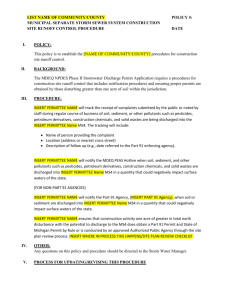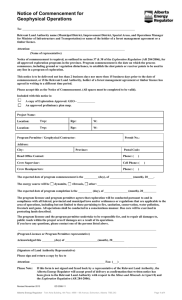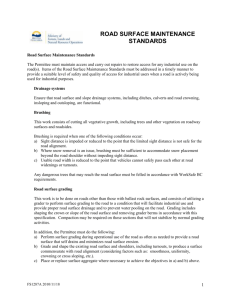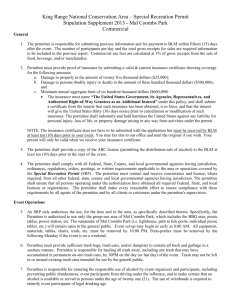doc - Division of Air Quality
advertisement
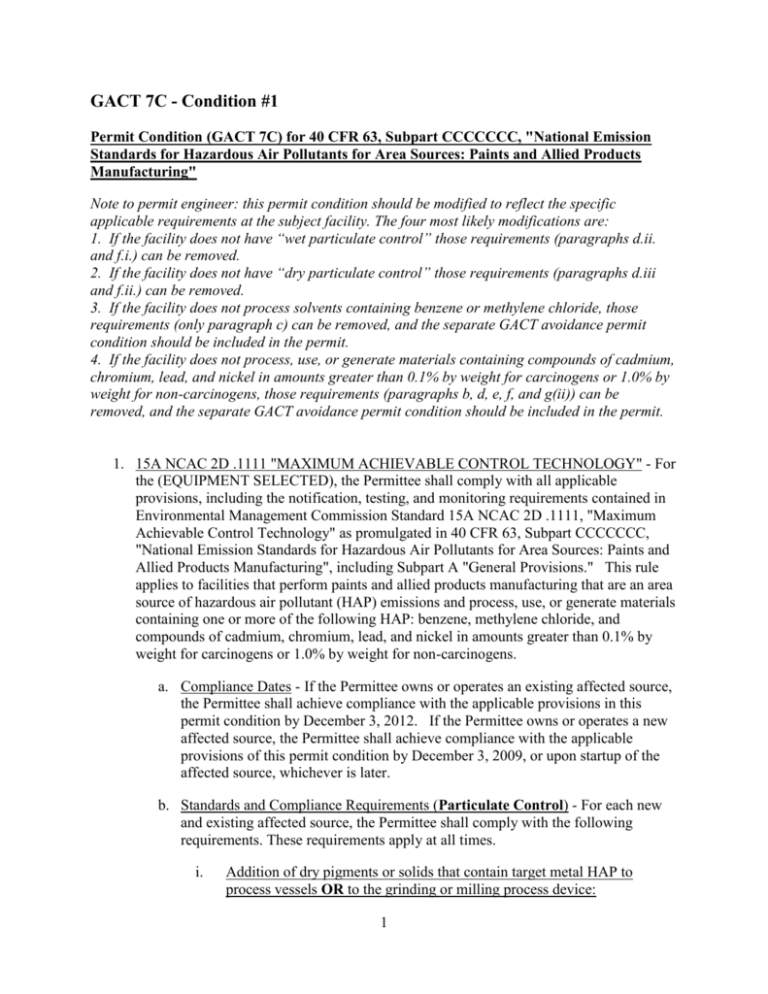
GACT 7C - Condition #1 Permit Condition (GACT 7C) for 40 CFR 63, Subpart CCCCCCC, "National Emission Standards for Hazardous Air Pollutants for Area Sources: Paints and Allied Products Manufacturing" Note to permit engineer: this permit condition should be modified to reflect the specific applicable requirements at the subject facility. The four most likely modifications are: 1. If the facility does not have “wet particulate control” those requirements (paragraphs d.ii. and f.i.) can be removed. 2. If the facility does not have “dry particulate control” those requirements (paragraphs d.iii and f.ii.) can be removed. 3. If the facility does not process solvents containing benzene or methylene chloride, those requirements (only paragraph c) can be removed, and the separate GACT avoidance permit condition should be included in the permit. 4. If the facility does not process, use, or generate materials containing compounds of cadmium, chromium, lead, and nickel in amounts greater than 0.1% by weight for carcinogens or 1.0% by weight for non-carcinogens, those requirements (paragraphs b, d, e, f, and g(ii)) can be removed, and the separate GACT avoidance permit condition should be included in the permit. 1. 15A NCAC 2D .1111 "MAXIMUM ACHIEVABLE CONTROL TECHNOLOGY" - For the (EQUIPMENT SELECTED), the Permittee shall comply with all applicable provisions, including the notification, testing, and monitoring requirements contained in Environmental Management Commission Standard 15A NCAC 2D .1111, "Maximum Achievable Control Technology" as promulgated in 40 CFR 63, Subpart CCCCCCC, "National Emission Standards for Hazardous Air Pollutants for Area Sources: Paints and Allied Products Manufacturing", including Subpart A "General Provisions." This rule applies to facilities that perform paints and allied products manufacturing that are an area source of hazardous air pollutant (HAP) emissions and process, use, or generate materials containing one or more of the following HAP: benzene, methylene chloride, and compounds of cadmium, chromium, lead, and nickel in amounts greater than 0.1% by weight for carcinogens or 1.0% by weight for non-carcinogens. a. Compliance Dates - If the Permittee owns or operates an existing affected source, the Permittee shall achieve compliance with the applicable provisions in this permit condition by December 3, 2012. If the Permittee owns or operates a new affected source, the Permittee shall achieve compliance with the applicable provisions of this permit condition by December 3, 2009, or upon startup of the affected source, whichever is later. b. Standards and Compliance Requirements (Particulate Control) - For each new and existing affected source, the Permittee shall comply with the following requirements. These requirements apply at all times. i. Addition of dry pigments or solids that contain target metal HAP to process vessels OR to the grinding or milling process device: 1 A. Operate a capture system that minimizes fugitive particulate emissions and route them to a control device with visible emissions of less than 10% opacity. The opacity requirement does not apply to particulate control devices that do not vent to the atmosphere; OR B. Add pigments and solids to vessels in liquid, slurry, or paste form. ii. Grinding and milling of materials containing the target metal HAP: A. Capture particulate emissions and route them to a control device with visible emissions of less than 10% opacity. The opacity requirement does not apply to particulate control devices that do not vent to the atmosphere; OR B. Fully enclose the grinding and milling equipment during this process; OR C. Ensure that the pigments and solids are in the solution during the grinding and milling. c. Standards and Compliance Requirements (Benzene and Methylene Chloride Control Only) - For each new and existing affected source, the Permittee shall comply with the following requirements: i. Process and storage vessels that store or process materials containing benzene or methylene chloride, except for process vessels which are mixing vessels, shall be equipped with covers or lids meeting the requirements of (A) through (C) below. A. The covers or lids can be of solid or flexible construction, provided they do not warp or move around during the manufacturing process. B. The covers or lids shall maintain contact along at least 90 percent of the vessel rim. C. The covers or lids shall be maintained in good condition. ii. Mixing vessels that store or process materials containing benzene or methylene chloride shall be equipped with covers that completely cover the vessel, except for safe clearance of the mixer shaft. iii. All vessels that store or process materials containing benzene or methylene chloride shall be kept covered at all times, except for quality control testing and product sampling, addition of materials, material removal, or when the vessel is empty. Empty vessel is defined in 40 CFR 63.11601(b)(3). 2 iv. Leaks and spills of materials containing benzene or methylene chloride shall be minimized and cleaned up as soon as practical, but no longer than 1 hour from the time of detection. v. Rags or other materials that use a solvent containing benzene or methylene chloride for cleaning shall be kept in a closed container. d. Initial Particulate Control Device Inspection - The Permittee shall conduct an initial inspection of each particulate control device according to the following requirements: i. The Permittee shall conduct each inspection no later than 180 days after the applicable compliance date (conduct by June 1, 2013 for existing sources). ii. For each wet particulate control system, the Permittee shall verify the presence of water flow to the control equipment. The Permittee shall also visually inspect the system ductwork and control equipment for leaks and inspect the interior of the control equipment (if applicable) for structural integrity and the condition of the control system. iii. For each dry particulate control system, the Permittee shall visually inspect the system ductwork and dry particulate control unit for leaks. The Permittee shall also inspect the inside of each dry particulate control unit for structural integrity and condition. iv. An initial inspection of the internal components of the particulate control system is not required if there is a record that an inspection meeting the requirements of this subsection has been performed within the past 12 months and any maintenance actions have been resolved. e. Initial Particulate Control Device Compliance Test Requirements – i. The Permittee shall conduct the initial compliance test no later than 180 days after the applicable compliance date (conduct by June 1, 2013 for existing sources). ii. For each particulate control device, the Permittee shall conduct a visible emission test consisting of three 1-minute test runs using Method 203C (40 CFR part 51, appendix M). The visible emission test runs shall be performed during the addition of dry pigments and solids containing compounds of cadmium, chromium, lead, or nickel to a process vessel or to the grinding and milling equipment. If the average test results of the visible emissions test runs indicate opacity greater than 10%, the Permittee shall take corrective action and retest within 15 days. iii. At least 45 days prior to performing the required emissions testing, the Permittee shall submit a testing protocol to the Regional Supervisor, DAQ 3 for review and approval. All testing protocols shall be approved by the DAQ prior to performing such tests; and iv. To afford the Regional Supervisor, DAQ, the opportunity to have an observer present, the Permittee shall PROVIDE the Regional Office, in WRITING, at least 7 days notice of any required performance test. v. The results of this test shall be submitted with the Notification of Compliance Status. f. Ongoing Particulate Control Device Inspection and Testing Requirements – i. Wet Particulate Control System Inspection Requirements: The Permittee shall inspect and maintain each wet particulate control system according to the following requirements: A. The Permittee shall conduct a daily inspection to verify the presence of water flow to the wet particulate control system. B. The Permittee shall conduct weekly visual inspections of any flexible ductwork for leaks. C. The Permittee shall conduct inspections of the rigid, stationary ductwork for leaks, and the interior of the wet control system (if applicable) to determine the structural integrity and condition of the control equipment every 12 months. ii. Dry Particulate Control System Inspection Requirements: The Permittee shall inspect and maintain each dry particulate control system according to the following requirements. A. The Permittee shall conduct weekly visual inspections of any flexible ductwork for leaks. B. The Permittee shall conduct inspections of the rigid, stationary ductwork for leaks, and the interior of the dry particulate control unit for structural integrity and to determine the condition of the fabric filter (if applicable) every 12 months. iii. Ongoing Visual Testing Requirements for Particulate Control Systems: For each particulate control device, the Permittee shall conduct a 5-minute visual determination of emissions from the particulate control device every 3 months using Method 22 (40 CFR part 60, appendix A–7). The visible emission test shall be performed during the addition of dry pigments and solids containing compounds of cadmium, chromium, lead, or nickel to a process vessel or to the grinding and milling equipment. If visible emissions are observed for two minutes of the required 5-minute observation period, the Permittee shall conduct a Method 203C (40 CFR 4 part 51, appendix M) test within 15 days of the time when visible emissions were observed. The Method 203C test will consist of three 1minute test runs and shall be performed during the addition of dry pigments and solids containing compounds of cadmium, chromium, lead, or nickel HAP to a process vessel or to the grinding and milling equipment. If the Method 203C test runs indicates greater than 10% opacity visible emissions, the Permittee shall comply with the following: A. The Permittee shall take corrective action and retest using Method 203C within 15 days. The Method 203C test will consist of three 1-minute test runs and shall be performed during the addition of dry pigments and solids containing compounds of cadmium, chromium, lead, or nickel to a process vessel or to the grinding and milling equipment. The Permittee shall continue to take corrective action and retest each 15 days until a Method 203C test indicates an opacity equal to or less than 10% opacity. B. The Permittee shall prepare a deviation report in accordance with §63.11603(b)(3) for each instance in which the Method 203C opacity results were greater than the limitation in §63.11601(a)(5). C. The Permittee shall resume the visible determinations of emissions from the particulate control device in accordance with the requirements of this section 3 months after the previous visible determination. g. Recordkeeping Requirements - In accordance with 40 CFR 63.11602 and 63.11603, the Permittee shall maintain records of the following: i. Copies of the Initial Notification of Applicability, the Notification of Compliance Status, and each Annual Compliance Certification Report. ii. The Permittee shall record the following information for each inspection and testing activity: A. The date, place, and time; B. Person conducting the activity; C. Technique or method used; D. Operating conditions during the activity; E. Results; and F. Description of correction actions taken. 5 iii. The Permittee shall keep each record for 5 years following the date of each recorded action. The Permittee shall keep each record onsite for at least 2 years after the date of each recorded action according to §63.10(b)(1). The Permittee may keep the records offsite for the remaining 3 years. h. Reporting Requirements - In addition to the notification requirements of the Environmental Protection Agency (EPA), the Permittee is required to NOTIFY the Regional Supervisor, DAQ, in WRITING, of the following: i. An Initial Notification of Applicability including a description of the affected sources shall be submitted in accordance with 40 CFR 63.1160(a). For existing affected sources that commenced startup on or before June 1, 2009, the initial notification must be submitted by June 1, 2010. For sources that commenced startup after June 1, 2009, the notification must be submitted no later than 180 days after initial startup. ii. A Notification of Compliance Status shall be submitted on or before June 3, 2013 for any existing source subject to this Subpart or 180 days after the initial startup of a new source subject to this Subpart. The notice shall contain the following information: A. The company's name and address; B. A statement by a responsible official with that official's name, title, phone number, e-mail address and signature, certifying the truth, accuracy, and completeness of the notification, a description of the method of compliance (i.e., compliance with management practices, installation of a wet or dry scrubber) and a statement of whether the source has complied with all the relevant standards and other requirements of this subpart. C. A copy of the initial particulate control device compliance test, if applicable. iii. An Annual Compliance Certification report shall be prepared by January 31 of each year. This report does not need to be submitted unless a deviation from the requirements of this subpart has occurred. If a deviation has occurred during the year, each annual compliance certification report shall be submitted along with the deviation report, and postmarked no later than February 15. The report shall contain the following information: A. Company name and address; B. A statement in accordance with §63.9(h) of the General Provisions that is signed by a responsible official with that official's name, 6 title, phone number, e-mail address and signature, certifying the truth, accuracy, and completeness of the notification and a statement of whether the source has complied with all the relevant standards and other requirements of this subpart; and C. Date of report and beginning and ending dates of the reporting period. D. Deviation Report - If a deviation has occurred during the reporting period, the Permittee shall include a description of deviations from the applicable requirements, the time periods during which the deviations occurred, and the corrective actions taken. This deviation report shall be submitted along with the annual compliance certification report. 7
